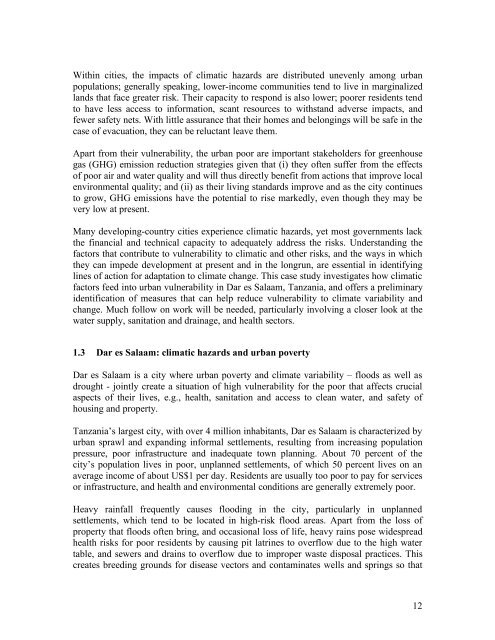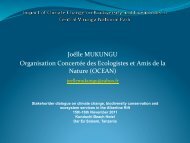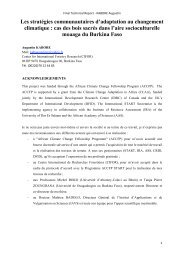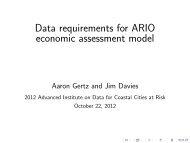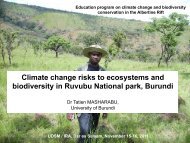Urban Poverty & Climate Change in Dar es Salaam, Tanzania:
Urban Poverty & Climate Change in Dar es Salaam, Tanzania:
Urban Poverty & Climate Change in Dar es Salaam, Tanzania:
You also want an ePaper? Increase the reach of your titles
YUMPU automatically turns print PDFs into web optimized ePapers that Google loves.
With<strong>in</strong> citi<strong>es</strong>, the impacts of climatic hazards are distributed unevenly among urban<br />
populations; generally speak<strong>in</strong>g, lower-<strong>in</strong>come communiti<strong>es</strong> tend to live <strong>in</strong> marg<strong>in</strong>alized<br />
lands that face greater risk. Their capacity to r<strong>es</strong>pond is also lower; poorer r<strong>es</strong>idents tend<br />
to have l<strong>es</strong>s acc<strong>es</strong>s to <strong>in</strong>formation, scant r<strong>es</strong>ourc<strong>es</strong> to withstand adverse impacts, and<br />
fewer safety nets. With little assurance that their hom<strong>es</strong> and belong<strong>in</strong>gs will be safe <strong>in</strong> the<br />
case of evacuation, they can be reluctant leave them.<br />
Apart from their vulnerability, the urban poor are important stakeholders for greenhouse<br />
gas (GHG) emission reduction strategi<strong>es</strong> given that (i) they often suffer from the effects<br />
of poor air and water quality and will thus directly benefit from actions that improve local<br />
environmental quality; and (ii) as their liv<strong>in</strong>g standards improve and as the city cont<strong>in</strong>u<strong>es</strong><br />
to grow, GHG emissions have the potential to rise markedly, even though they may be<br />
very low at pr<strong>es</strong>ent.<br />
Many develop<strong>in</strong>g-country citi<strong>es</strong> experience climatic hazards, yet most governments lack<br />
the f<strong>in</strong>ancial and technical capacity to adequately addr<strong>es</strong>s the risks. Understand<strong>in</strong>g the<br />
factors that contribute to vulnerability to climatic and other risks, and the ways <strong>in</strong> which<br />
they can impede development at pr<strong>es</strong>ent and <strong>in</strong> the longrun, are <strong>es</strong>sential <strong>in</strong> identify<strong>in</strong>g<br />
l<strong>in</strong><strong>es</strong> of action for adaptation to climate change. This case study <strong>in</strong>v<strong>es</strong>tigat<strong>es</strong> how climatic<br />
factors feed <strong>in</strong>to urban vulnerability <strong>in</strong> <strong>Dar</strong> <strong>es</strong> <strong>Salaam</strong>, <strong>Tanzania</strong>, and offers a prelim<strong>in</strong>ary<br />
identification of measur<strong>es</strong> that can help reduce vulnerability to climate variability and<br />
change. Much follow on work will be needed, particularly <strong>in</strong>volv<strong>in</strong>g a closer look at the<br />
water supply, sanitation and dra<strong>in</strong>age, and health sectors.<br />
1.3 <strong>Dar</strong> <strong>es</strong> <strong>Salaam</strong>: climatic hazards and urban poverty<br />
<strong>Dar</strong> <strong>es</strong> <strong>Salaam</strong> is a city where urban poverty and climate variability – floods as well as<br />
drought - jo<strong>in</strong>tly create a situation of high vulnerability for the poor that affects crucial<br />
aspects of their liv<strong>es</strong>, e.g., health, sanitation and acc<strong>es</strong>s to clean water, and safety of<br />
hous<strong>in</strong>g and property.<br />
<strong>Tanzania</strong>’s larg<strong>es</strong>t city, with over 4 million <strong>in</strong>habitants, <strong>Dar</strong> <strong>es</strong> <strong>Salaam</strong> is characterized by<br />
urban sprawl and expand<strong>in</strong>g <strong>in</strong>formal settlements, r<strong>es</strong>ult<strong>in</strong>g from <strong>in</strong>creas<strong>in</strong>g population<br />
pr<strong>es</strong>sure, poor <strong>in</strong>frastructure and <strong>in</strong>adequate town plann<strong>in</strong>g. About 70 percent of the<br />
city’s population liv<strong>es</strong> <strong>in</strong> poor, unplanned settlements, of which 50 percent liv<strong>es</strong> on an<br />
average <strong>in</strong>come of about US$1 per day. R<strong>es</strong>idents are usually too poor to pay for servic<strong>es</strong><br />
or <strong>in</strong>frastructure, and health and environmental conditions are generally extremely poor.<br />
Heavy ra<strong>in</strong>fall frequently caus<strong>es</strong> flood<strong>in</strong>g <strong>in</strong> the city, particularly <strong>in</strong> unplanned<br />
settlements, which tend to be located <strong>in</strong> high-risk flood areas. Apart from the loss of<br />
property that floods often br<strong>in</strong>g, and occasional loss of life, heavy ra<strong>in</strong>s pose wid<strong>es</strong>pread<br />
health risks for poor r<strong>es</strong>idents by caus<strong>in</strong>g pit latr<strong>in</strong><strong>es</strong> to overflow due to the high water<br />
table, and sewers and dra<strong>in</strong>s to overflow due to improper waste disposal practic<strong>es</strong>. This<br />
creat<strong>es</strong> breed<strong>in</strong>g grounds for disease vectors and contam<strong>in</strong>at<strong>es</strong> wells and spr<strong>in</strong>gs so that<br />
12


